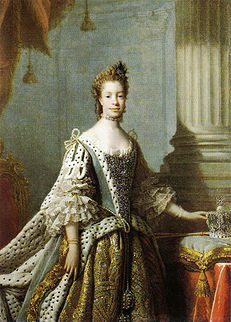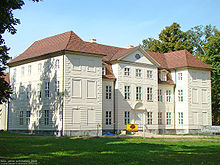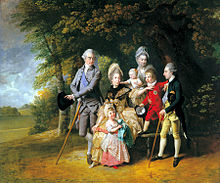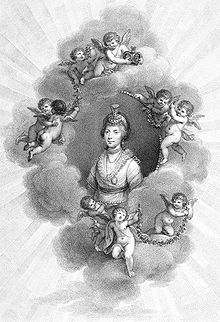- Charlotte of Mecklenburg-Strelitz
-
"Queen Charlotte" redirects here. For other uses, see Queen Charlotte (disambiguation).
Charlotte of Mecklenburg-Strelitz (19 May 1744 – 17 November 1818) was the Queen consort of the United Kingdom as the wife of King George III. She was also the electress consort of Hanover in the Holy Roman Empire until the promotion of her husband to King of Hanover on 12 October 1814, which made her Queen consort of Hanover.
Queen Charlotte was a patroness of the arts, known to Johann Christian Bach and Wolfgang Amadeus Mozart, among others. She was also an amateur botanist who helped expand Kew Gardens. George III and Charlotte had 15 children, 13 of whom survived to adulthood.
Contents
Early life
Sophia Charlotte was born on 19 May 1744. She was the youngest daughter of Duke Charles Louis Frederick of Mecklenburg-Strelitz, Prince of Mirow and his wife Princess Elizabeth Albertine of Saxe-Hildburghausen. Mecklenburg-Strelitz was a small north German duchy in the Holy Roman Empire.
She was a granddaughter of Adolf Frederick II, Duke of Mecklenburg-Strelitz, by his third wife, Christiane Emilie Antonie, Princess of Schwarzburg-Sondershausen. Her father's elder half brother reigned from 1708 to 1753 as Adolf Friedrich III.
The children of Duke Charles were all born at Schloss Mirow, a modest palace, or rather country house. The daily life at Mirow was nearly identical to that of the family of a simple English country gentleman.[1] The morning was devoted to study and instruction in needlework, embroidery, and lace-making, in which the daughters were very skillful. They were brought up in the most careful way, receiving an admirable education, and were grounded in religious principles under the direction of their mother.[2] They were further directed by M. Gentzner, a Lutheran minister of many accomplishments, who had a particular knowledge of botany, mineralogy, and science.[1]
Marriage
When King George III succeeded to the throne of Great Britain upon the death of his grandfather, George II, it was considered high time for him to seek a bride who could fulfill all the duties of her exalted position in a manner that would satisfy the feelings of the country at large.[3] George was originally smitten with Lady Sarah Lennox, sister of the Duke of Richmond, but his mother Princess Augusta of Saxe-Gotha, the Dowager Princess of Wales, and his political advisor Lord Bute advised against the match, and George abandoned the idea.
Colonel Graeme, who had been sent to the various courts of Germany on a mission of investigation, reported the charms of character and the excellent qualities of mind possessed by the seventeen-year-old Princess Charlotte.[4] While she certainly was not a beauty, her countenance was very expressive and showed extreme intelligence; she was not tall, but had a slight, rather pretty figure; her bright eyes sparkled with good humour and vivacity; her mouth was large, but filled with white and even teeth; and her hair was a beautiful light brown colour.[3]
The King announced to his Council in July 1761, according to the usual form, his intention to wed the Princess, and Lord Hardwicke was despatched to Mecklenburg to solicit her hand in the King's name.[5] Charlotte's brother Adolf Friedrich IV, Duke of Mecklenburg-Strelitz, and widowed mother, who actively sought a prominent marriage for the young princess, received him with every honour that the little court was capable of showing him, and he returned within a month of his departure after completing all the necessary preliminaries, well pleased with his mission.[5]
By the end of August 1761, a party of escorts departed for Germany to conduct Princess Charlotte to England: the Duchess of Ancaster, the Duchess of Hamilton, both Ladies of the Bedchamber; Mrs. Tracey, Bedchamber Woman; Earl Harcourt, Proxy for the King; and General Graeme.[3] A bad thunderstorm overtook them on the way, and lightning set fire to several trees along a road through which they had to pass.[6]
They arrived nevertheless in safety at Cuxhaven and embarked on a squadron of British yachts and warships under Admiral Anson (including the specially renamed HMY Royal Charlotte). They were nine days at sea due to a storm, the voyage being usually accomplished in about three days. Instead of going on to land at Greenwich, where everything was prepared for the reception of the Princess, Admiral Anson thought it better to make for the nearest port and docked at Harwich, where they remained at anchor for the night. This was on Sunday, the 6th of September. Landing the next morning, they travelled to Essex, where they rested, and then continued their journey towards London. Arriving at St. James's Palace on 7 September, the Princess met the King and the royal family. The following day at nine o'clock, the wedding ceremony took place in the Chapel Royal and was performed by the Archbishop of Canterbury, Thomas Secker.[7]
Life as Queen
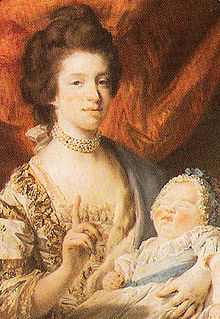 In 1767, Francis Cotes drew a pastel of Queen Charlotte with her eldest daughter Charlotte, Princess Royal. Lady Mary Coke called the likeness "so like that it could not be mistaken for any other person".[8]
In 1767, Francis Cotes drew a pastel of Queen Charlotte with her eldest daughter Charlotte, Princess Royal. Lady Mary Coke called the likeness "so like that it could not be mistaken for any other person".[8]
Unfortunately, there can be little doubt that the early married life of the young Queen was scarcely a happy one. The King was burdened with ministerial troubles, and his mother, secure in the support of his favourite Lord Bute, was able to exert all the influence and authority which age and knowledge of the world and the position of a parent could give her over a young and inexperienced couple.[9] The young queen was unable to resist, and a sort of palace despotism developed where her mother-in-law controlled all her actions. The King himself, strongly under his mother's influence, was not inclined to interfere and assumed that all was done rightly. Already she was not allowed to be too intimate with the English ladies of her household. It was laid down as being formal etiquette of the court that they should not approach her save under the direction of her German attendants. Card-playing, which she loved, was presently interdicted.[10]
Naturally, too, there were the German and the English factions of dependents, each jealously contending for their royal mistress's favour, dictating the terms and conditions of their service, and threatening to go back to Germany unless particular privileges were given them. The poor queen had about as much anxiety and trouble with her dependents as her husband had with his insubordinate ministers or servants.[11]
Despite this the marriage was a success, and on 12 August 1762, the Queen gave birth to her first child, the Prince of Wales, who would later become King George IV. On 13 September, the Queen attended the Chapel Royal to offer the usual thanksgiving that took place after childbirth. The ceremony of christening the Prince of Wales, which took place at St. James's Palace, was attended with every circumstance of splendour. The cradle upon which the infant lay was covered with a magnificent drapery of Brussels lace.[12] In the course of their marriage, they had 15 children, all but two of whom (Octavius and Alfred) survived into adulthood.
Around this time the King and Queen moved to Buckingham House, at the western end of St. James's Park, which would later be known as Buckingham Palace. The house which forms the architectural core of the present palace was built for the first Duke of Buckingham and Normanby in 1703 to the design of William Winde. Buckingham House was eventually sold by Buckingham's descendant, Sir Charles Sheffield, in 1761 to George III for £21,000[13] (£3,000,000 as of 2011).[14]
The house was originally intended as a private retreat, in particular for Charlotte, and was known as The Queen's House[15]—14 of their 15 children were born there. St. James's Palace remained the official and ceremonial royal residence.[16]
Interests and patronage
George III and Queen Charlotte were music connoisseurs and passionate admirers of George Frideric Handel; both had German taste, and gave special honour to German artists and composers.[17]
In 1764 Wolfgang Amadeus Mozart, then aged eight, arrived in Britain with his family as part of their grand tour of Europe and remained from April 1764 until July 1765.[18] The Mozarts were summoned to court on 19 May and played before a limited circle from six to ten o'clock. Johann Christian Bach, eleventh son of the great Johann Sebastian Bach, was then music-master to the Queen, and put difficult works of Handel, Bach, and Abel before the boy. He played them all at sight, and those present were quite amazed.[19] Afterwards he accompanied the Queen in an aria which she sang, and played a solo work on the flute.[20] On 29 October, they were in town again, and were invited to court to celebrate the fourth anniversary of the King's accession. As a memento of the royal favour, his father Leopold Mozart published six sonatas composed by Wolfgang, known as Mozart's Opus 3, and were dedicated to the Queen on 18 January 1765, a dedication she rewarded with a present of fifty guineas.[21]
Queen Charlotte was an amateur botanist who took a great interest in Kew Gardens, and, in an age of discovery, when travellers and explorers such as Captain Cook and Sir Joseph Banks were constantly bringing home new species and varieties of plants, saw that the collections were greatly enriched and expanded.[22] Her interest in botany led to the magnificent South African flower, the Bird of Paradise, being named Strelitzia reginae in her honour.[23]
Among the royal couple's favored craftsmen and artists were the cabinetmaker William Vile, silversmith Thomas Heming, the landscape designer Capability Brown, and the German painter Johann Zoffany, who frequently painted the king and queen and their children in charmingly informal scenes, such as a portrait of Queen Charlotte and her children as she sat at her dressing table.[24]
The queen also founded orphanages and a hospital for expectant mothers. The education of women was of great importance to her, and she saw to it that her daughters were better educated than was usual for young women of the day. However, she insisted that her daughters live restricted lives close to their mother, and refused to allow them to marry until they were well-advanced in years, with the result that none of her daughters had legitimate issue (one, Princess Sophia, may have had an illegitimate son).
In 2004, the Queen's Gallery at Buckingham Palace staged an exhibition illustrating George and Charlotte's enthusiastic arts patronage, which was particularly enlightened in contrast to that of earlier Hanoverian monarchs; it compared favorably to the adventuresome tastes of the king's father, Frederick, Prince of Wales.
Up until 1788, portraits of Charlotte often depict her in maternal poses with her children, and she looks young and contented.[25] However, in that year her husband fell seriously ill and became temporarily insane. It is now thought that the King was suffering from a genetic metabolic disorder, porphyria, but at the time the cause of the King's illness was unknown. Sir Thomas Lawrence's portrait of her at this time marks a transition point after which she looks much older in her portraits. Indeed, the Assistant Keeper of Charlotte's Wardrobe, Mrs. Papendiek, wrote that the Queen was "much changed, her hair quite grey".[26]
Relations with Marie Antoinette
 Charlotte sat for Sir Thomas Lawrence in September 1789. His portrait of her was exhibited at the Royal Academy the following year. Reviewers thought it "a strong likeness".[27]
Charlotte sat for Sir Thomas Lawrence in September 1789. His portrait of her was exhibited at the Royal Academy the following year. Reviewers thought it "a strong likeness".[27]
The French Revolution of 1789 probably added to the strain that Charlotte felt.[28] Queen Charlotte and Queen Marie Antoinette of France kept a close relationship. Charlotte was eleven years older than Marie Antoinette, yet they shared many interests, such as their love of music and the arts in which they both enthusiastically took an interest. Never meeting face to face, they kept their friendship to pen and paper. Marie Antoinette confided in Charlotte upon the outbreak of the French Revolution. Charlotte had even organized apartments to be prepared and ready for the refugee royal family of France to stay in.[29] After the execution of Marie Antoinette and the bloody events that followed, Charlotte was said to be shocked and overwhelmed that such a thing could happen to a kingdom, and right on Britain's doorstep.
Husband's illness
After the onset of his madness, George III was placed in the care of his wife, who could not bring herself to visit him very often, due to his erratic behaviour and occasional violent reactions. It is believed she did not visit him again after June 1812. However, Charlotte remained supportive of her husband as his illness, now believed to be porphyria, worsened in old age. While her son, the Prince Regent, wielded the royal power, she was her husband's legal guardian from 1811 until her death in 1818.
Later life
The queen died in the presence of her eldest son, the Prince Regent, who was holding her hand as she sat in an armchair at the family's country retreat, Dutch House in Surrey (now known as Kew Palace). She was buried at St George's Chapel at Windsor Castle. Her husband died just over a year later. She is the second longest-serving consort in British history (after the present Duke of Edinburgh), having served as such from her marriage (on 8 September 1761) to her death (17 November 1818), a total of 57 years and 70 days.
Her eldest son, the Prince Regent, claimed Charlotte's jewels at her death, but the rest of her property was sold at auction from May to August 1819. Her clothes, furniture, and even her snuff were sold by Christie's.[30] It is highly unlikely that her husband ever knew of her death, and he died blind, deaf, lame and insane fourteen months later.
Legacy
The Queen Charlotte Islands are named after her. The cities of Charlottesville, Virginia, Charlottetown, Prince Edward Island and Charlotte, North Carolina, are also named in her honor; the latter is in Mecklenburg County, also named after her, as is Fort Charlotte near Kingstown, capital of Saint Vincent and the Grenadines. The proposed North American colonies of Vandalia (because of her supposed Vandal ancestry; see above)[31][32][33] and Charlotina were also named for her.[34]
Queen Charlotte was played by actress Frances White in the 1979 BBC series Prince Regent and later by Helen Mirren in the film The Madness of King George (1994).
Titles, style, honours and arms
Styles of
Queen Charlotte as consort
Reference style Her Majesty Spoken style Your Majesty Alternative style Ma'am Titles and styles
- 19 May 1744 – 8 September 1761: Her Serene Highness Princess Charlotte of Mecklenburg[35] or Her Serene Highness Duchess Sophia Charlotte of Mecklenburg, Princess of Wenden, Schwerin and Ratzeburg, Countess of Schwerin, Lady of the Lands of Rostock and Stargard[36]
- 8 September 1761 – 17 November 1818: Her Majesty The Queen
Arms
The Royal Coat of Arms of the United Kingdom are impaled with her father's arms as a Duke of Mecklenburg-Strelitz. The arms were: Quarterly of six, 1st, Or, a buffalo's head cabossed Sable, armed and ringed Argent, crowned and langued Gules (Mecklenburg); 2nd, Azure, a griffin segreant Or (Rostock); 3rd, Per fess, in chief Azure, a griffin segreant Or, and in the base Vert, a bordure Argent (Principality of Schwerin); 4th, Gules, a cross patée Argent crowned Or (Ratzeburg); 5th, Gules, a dexter arm Argent issuant from clouds in sinister flank and holding a finger ring Or (County of Schwerin); 6th, Or, a buffalo's head Sable, armed Argent, crowned and langued Gules (Wenden); Overall an inescutcheon, per fess Gules and Or (Stargard).[37]
The Queen's arms changed twice to mirror the changes in her husband's arms, once in 1801 and then again in 1816. A funeral hatchment displaying the Queen's full coat of arms painted in 1818, is on display at Kew Palace.[38]
Issue
Name Birth Death Notes George IV 12 August 1762 26 June 1830 married 1795, Princess Caroline of Brunswick-Wolfenbüttel; had issue, but no descendants today The Prince Frederick, Duke of York and Albany 16 August 1763 5 January 1827 married 1791, Princess Frederica of Prussia; no issue William IV 21 August 1765 20 June 1837 married 1818, Princess Adelaide of Saxe-Meiningen; no surviving legitimate issue, but has illegitimate descendants, including David Cameron, the present Prime Minister Charlotte, Princess Royal 29 September 1766 6 October 1828 married 1797, King Frederick of Württemberg; no surviving issue The Prince Edward, Duke of Kent and Strathearn 2 November 1767 23 January 1820 married 1818, Princess Victoria of Saxe-Coburg-Saalfeld; had issue, descendants are today's royal family through his daughter, Victoria The Princess Augusta Sophia 8 November 1768 22 September 1840 never married, no issue The Princess Elizabeth 22 May 1770 10 January 1840 married 1818, Frederick, Landgrave of Hesse-Homburg; no issue Ernest Augustus I of Hanover 5 June 1771 18 November 1851 married 1815, Princess Friederike of Mecklenburg-Strelitz; had issue; has descendants today The Prince Augustus Frederick, Duke of Sussex 27 January 1773 21 April 1843 (1) married in contravention of the Royal Marriages Act 1772, The Lady Augusta Murray; had issue; marriage annulled 1794
(2) married 1831, The Lady Cecilia Buggin (later 1st Duchess of Inverness); no issueThe Prince Adolphus, Duke of Cambridge 24 February 1774 8 July 1850 married 1818, Princess Augusta of Hesse-Cassel; had issue; has descendants today The Princess Mary, Duchess of Gloucester 25 April 1776 30 April 1857 married 1816, Prince William, Duke of Gloucester; no issue The Princess Sophia 3 November 1777 27 May 1848 never married, no (legitimate) issue The Prince Octavius 23 February 1779 3 May 1783 died in childhood The Prince Alfred 22 September 1780 20 August 1782 died in childhood The Princess Amelia 7 August 1783 2 November 1810 never married, no issue Ancestry
Ancestors of Charlotte of Mecklenburg-Strelitz 16. Johann VII, Duke of Mecklenburg-Schwerin 8. Adolf Frederick I, Duke of Mecklenburg-Schwerin 17. Princess Sophie of Holstein-Gottorp 4. Adolphus Frederick II, Duke of Mecklenburg-Strelitz 18. Julius Ernst, Duke of Brunswick-Dannenberg 9. Duchess Maria Katharina of Brunswick-Dannenberg 19. Countess Marie of Ostfriesland 2. Duke Charles Louis Frederick of Mecklenburg-Strelitz 20. Anton Günther I, Count of Schwarzburg-Sondershausen 10. Christian Wilhelm I, Prince of Schwarzburg-Sondershausen 21. Countess Palatine Marie Magdalene of Birkenfeld 5. Princess Christiane of Schwarzburg-Sondershausen 22. Count Albert Friedrich of Barby-Muhlingen 11. Countess Antoine Sybille of Barby-Muhlingen 23. Countess Sophie Ursula of Oldenburg 1. Charlotte of Mecklenburg-Strelitz 24. Ernest I, Duke of Saxe-Gotha and Altenburg 12. Ernest, Duke of Saxe-Hildburghausen 25. Princess Elisabeth Sophie of Saxe-Altenburg 6. Ernest Frederick I of Saxe-Hildburghausen 26. Prince Georg Friedrich of Waldeck 13. Countess Sophie of Waldeck 27. Countess Elisabeth Charlotte of Nassau-Siegen 3. Princess Elizabeth Albertine of Saxe-Hildburghausen 28. Georg Albrecht I, Count of Erbach 14. Georg Ludwig I, Count of Erbach-Erbach 29. Countess Elisabeth Dorothea of Hohenlohe-Waldenburg-Schillingsfürst 7. Countess Sophia Albertine of Erbach-Erbach 30. Count Philipp Theodor Waldeck-Eisenberg 15. Countess Amelie Katherine of Waldeck-Eisenberg 31. Countess Maria Magdalena of Nassau-Siegen Claims of African ancestry
Mario de Valdes y Cocom, an independent afrocentrist researcher, has argued[39] that Allan Ramsay, a noted abolitionist, frequently painted the Queen in works said to emphasize the alleged mulatto appearance of Charlotte, and that Ramsay's coronation portrait of Charlotte was sent to the colonies and was used by abolitionists as a de facto support for their cause. Valdes y Cocom goes on to state that, along with descriptions of a "mulatto face" (as, supposedely, Baron Stockmar, whom Valdes y Cocom wrongly considers Queen Charlotte's personal physician,[40] wrote in his autobiography),[39][41] the Queen's features had also been described as Vandalic, as exemplified by a poem written for the occasion of her marriage ("most literary of these allusions", according to Valdes y Cocom)[39]:
- "Descended from the warlike Vandal race,
- She still preserves that title in her face.
- Tho' shone their triumphs o'er Numidia's plain,
- And Andalusian[42] fields their name retain;
- They but subdued the southern world with arms,
- She conquers still with her triumphant charms,
- O! born for rule, - to whose victorious brow
- The greatest monarch of the north must bow."
Valdes y Cocom does not seem to take notice that the Vandals were a Germanic people originating from Northern Europe, that migrated first to Andalusia (modern southern Spain) in 409 AD, and afterwords to North Africa in 429 AD (namely to Numidia, were they established the Vandal Kingdom in North Africa), and that this poem is a eulogy linking Queen Charlotte to that distant Germanic nation, further straining the credulity of Charlotte's supposed Sub-Saharan African ethnicity. However, the phrase Vandal race, used to describe Queen Charlotte, is linked with an official ducal title of the House of Mecklenburg: Princeps Vandalorum, i.e. Prince of Wends, because of their overt Slavic origin.[43][44]
All this has led Mario de Valdes y Cocom to inquire about her ancestry and research her genealogy. Still according to Valdes y Cocom, one of the possibilities for Queen Charlotte's supposed racial features is that they were a concentration of traits inherited through three to six lines from a nine times removed ancestor of hers, Margarita de Castro e Souza, a 15th century Portuguese noblewoman who traced her ancestry six generations earlier to King Afonso III of Portugal and one of his lovers, Madragana.
Critics of this theory argue that Margarita's and Madragana's distant perch in the queen's family tree, respectively 9 and 15 generations removed, makes any presumed African ancestry, Northern or sub-Saharan, negligible and no more significant in Charlotte than in any other member of any German royal house at that time, and therefore that Charlotte could hardly be accurately described as "mulatto" or "African".[45] Like everyone else, Charlotte had 32,768 ancestors in the 15th generation up her family tree, and she shared descent from Madragana with a large proportion of Europe's royalty and nobility.
Even more, Valdez y Cocom assumed that Madragana was a Black African woman. In fact, a single author, Duarte Nunes de Leão, described her as a Moor,[46] that is to say, in the context of the Iberian Reconquista, someone of Islamic religion, regardless of actual ethnic origin (and that could have been Arab, North African Berber, or Muladi - native Iberian European Christians who converted to Islam after the arrival of the Moors, all of whom can be described as Caucasian or White). Modern researchers, however, believe Madragana to have been a Mozarab, that is to say an Iberian Christian living under Muslim control, of Sephardi Jewish origin.[47]
Valdez y Cocom has also argued, trying to defend the African origin of Queen Charlotte, that the Royal Household itself, at the time of Queen Elizabeth II's coronation in 1952, referred to both her Asian and African bloodlines in an apologia it published defending her position as head of the Commonwealth.[39] This is denied by Buckingham Palace.[48]
Notes and sources
- ^ a b Percy Hetherington Fitzgerald: The good Queen Charlotte, 1899; page 7
- ^ Charlotte Louise Henrietta Papendiek: Court and private life in the time of Queen Charlotte, 1887; page 3
- ^ a b c Charlotte Louise Henrietta Papendiek: Court and private life in the time of Queen Charlotte, 1887; page 9
- ^ Charlotte Louise Henrietta Papendiek: Court and private life in the time of Queen Charlotte, 1887; page 2-3
- ^ a b Charlotte Louise Henrietta Papendiek: Court and private life in the time of Queen Charlotte, 1887; page 4
- ^ Charlotte Louise Henrietta Papendiek: Court and private life in the time of Queen Charlotte, 1887; page 6
- ^ Percy Hetherington Fitzgerald: The good Queen Charlotte, 1899; page 32-33
- ^ Levey, pp.8–9
- ^ Percy Hetherington Fitzgerald: The good Queen Charlotte, 1899; page 51
- ^ Percy Hetherington Fitzgerald: The good Queen Charlotte, 1899; page 51-52
- ^ Percy Hetherington Fitzgerald: The good Queen Charlotte, 1899; page 52
- ^ Charlotte Louise Henrietta Papendiek: Court and private life in the time of Queen Charlotte, 1887; page 27
- ^ Nash, p. 18, although the purchase price is given by Wright p. 142 as £28,000
- ^ UK CPI inflation numbers based on data available from Lawrence H. Officer (2010) "What Were the UK Earnings and Prices Then?" MeasuringWorth.
- ^ In 1775, an Act of Parliament settled the property on Queen Charlotte, in exchange for her rights to Somerset House (see Old and New London (below)
- ^ Westminster: Buckingham Palace, Old and New London: Volume 4 (1878), pp. 61–74. Date accessed: 3 February 2009. The tradition persists of foreign ambassadors being formally accredited to "the Court of St. James's", even though it is at Buckingham Palace that they present their credentials and staff to the Queen upon their appointment.
- ^ Otto Jahn, Sir George Grove: Life of Mozart, Volume 1, 1882, page 39
- ^ Engel, Louis: From Mozart to Mario: Reminiscences of half a century, Volume 1, 1886, page 275
- ^ Engel, Louis: From Mozart to Mario: Reminiscences of half a century, Volume 1, 1886, page 39
- ^ Franz Eduard Gehring: Mozart, 1911, page 18
- ^ Otto Jahn, Sir George Grove: Life of Mozart, Volume 1, 1882, page 41
- ^ Murray, John: A handbook for travellers in Surrey, Hampshire, and the Isle of Wight, 1876, page 130-131
- ^ Missouri Botanical Garden: Missouri Botanical Garden bulletin, Volume 10, 1922, page 27
- ^ Levey, p.4
- ^ Levey, pp.7–8
- ^ Levey, p.7
- ^ Levey, p.16; the building in the distance is Eton College Chapel, as seen from Windsor Castle.
- ^ Levey, p.15
- ^ Fraser, Antonia: Marie Antoinette: The Journey, 2001; page 287
- ^ Baker, Kenneth (2005). George IV: A Life in Caricature. London: Thames & Hudson. ISBN 9780500251270. p.114.
- ^ Otis K. Rice and Stephen W. Brown. West Virginia: A History. 2nd Ed. University Press of Kentucky, 1994. p. 30. ISBN 978-0813118543
- ^ David W. Miller. The Taking of American Indian Lands in the Southeast: A History of Territorial Cessions and Forced Relocations, 1607-1840. McFarland, 2011. p. 41. ISBN 978-0786462773
- ^ Thomas J. Schaeper. Edward Bancroft: Scientist, Author, Spy. Yale University Press, 2011. p. 34. ISBN 978-0300118421
- ^ "The Expediency of Securing Our American Colonies, &c." (1763). p. 14. Reprinted in The Critical Period, 1763–1765. Volume 10 of the Collections of the Illinois State Historical Library. Clarence Walworth Alvord, ed. Illinois State Historical Library, 1915.p. 139.
- ^ London Gazette: no. 10138. p. 1. 8 September 1761.
- ^ Huish, Robert (1821) The public and private life of His late Excellent and Most Gracious Majesty, George the Third. Page 180
- ^ Pinches, John Harvey; Pinches, Rosemary (1974), The Royal Heraldry of England, Heraldry Today, Slough, Buckinghamshire: Hollen Street Press, p. 297, ISBN 090045525X
- ^ Queen Charlotte's hatchment Historic Royal Palaces website: Surprising stories, Retrieved 15 December 2010
- ^ a b c d PBS - The blurred racial lines of famous families - Queen Charlotte
- ^ In fact, Christian Friedrich Freiherr von Stockmar was personal physician not to Queen Charlotte, but to Prince Leopold of Saxe-Coburg-Gotha in 1816 at the time of Leopold's marriage to Princess Charlotte of the United Kingdom. See "Christian Friedrich, baron von Stockmar", in Encyclopædia Britannica (2010), retrieved 14 February 2010, and "Christian Friedrich Stockmar, Baron von", in The Columbia Encyclopedia, Sixth Edition (2008), retrieved 14 February 2010.
- ^ Valdes y Cocom credits this sources to the "History Department of McGill University. It was the director of the Burney Project (Fanny Burney, the prolific 19th century British diarist, had been secretary to the Queen), Dr. Joyce Hemlow, who obtained from Olwen Hedly, the most recent biographer of the Queen Charlotte (1975), at least half a dozen quotes by her contemporaries regarding her negroid features." (in PBS - The blurred racial lines of famous families - Queen Charlotte).
- ^ In the quote by Valdes y Cocom misquoted as "And and Alusian" (PBS - The blurred racial lines of famous families - Queen Charlotte), and further misquoted as "And Alusian" in One Hundred Great Black Britons. Andalusian, referring to "Andalusia" or "Vandalusia", is a word originating in the Arabic Al-Andalus, that was traditionally believed to be derived from "Vandal" (the Germanic tribe that colonized parts of Iberia from 407 to 429).
- ^ Erich Bauer, F. A. Pietzsch, Kritisches zur Anfangsgeschichte der Göttinger und Heidelberger Vandalia. Einst und Jetzt 10 (1965), S. 10
- ^ Albert Krantz, Wandalia oder Beschreibung Wendischer Geschicht, 1636
- ^ Stuart Jeffries, "Was this Britain's first black queen?" The Guardian, 12 March 2009.
- ^ Duarte Nunes de Leão,Crónica d'El Rei Dom Afonso III, 1600; modern edition: Duarte Nunes de Leão, Crónica dos Reis de Portugal, Porto, Lello & Irmão, 1975.
- ^ Anselmo Braamcamp Freire, Brasões da Sala de Sintra, 3 vols., Lisbon, Imprensa Nacional-Casa de Moeda, 1973; António Caetano de Sousa, História Genealógica da Casa Real Portuguesa, Coimbra, Atlântida-Livraria Editora, 1946; Felgueiras Gayo & Carvalhos de Basto, Nobiliário das Famílias de Portugal, Braga, 1989; José Augusto de Sotto Mayor Pizarro, Linhagens Medievais Portuguesas, 3 vols., Porto, Universidade Moderna, 1999; Manuel Abranches de Soveral, "Origem dos Souza ditos do Prado", in Machado de Vila Pouca de Aguiar. Ascendências e parentescos da Casa do Couto d'Além em Soutelo de Aguiar, Porto, 2000.
- ^ Letter from the Palace shown at OneDropRule.org - The Study of Racialism: Discussion of U.S. Racialism.
References
- Hedley, Olwen (1975). Queen Charlotte J Murray ISBN 0-7195-3104-7
- Levey, Michael (1977). A Royal Subject: Portraits of Queen Charlotte. London: National Gallery.
- Drinkuth, Friederike (2011). Queen Charlotte. A Princess from Mecklenburg-Strelitz ascends the Throne of England Thomas Helms Verlag Schwerin, ISBN 978-3-940207-79-1
External links and references
- Queen Charlotte, 1744–1818: A Bilingual Exhibit (c1994)
- The Blurred Racial Lines of Famous Families — Queen Charlotte at the PBS site
- Charlotte of Mecklenburg-Strelitz at Genealogics
- Royal Genealogies
- King George III: Mad or Misunderstood?
- The Search for Princess Charlotte
- Archival material relating to Charlotte of Mecklenburg-Strelitz listed at the UK National Register of Archives
- "Was this Britain's first black queen?" by Stuart Jeffries - The Guardian (March 2009)
- Margarida de Castro e Souza's full genealogy in a Portuguese Genealogical site
Charlotte of Mecklenburg-StrelitzBorn: 19 May 1744 Died: 17 November 1818British royalty Vacant Title last held byCaroline of AnsbachQueen consort of Great Britain and of Ireland
1761–1800Acts of Union 1800 New title
Previously Queen consort of Great Britain and of IrelandQueen consort of the United Kingdom
1801–1818Vacant Title next held byCaroline of BrunswickHanoverian royalty Vacant Title last held byCaroline of AnsbachElectress of Hanover
1761–1814Became queen consort New title
Previously electressQueen consort of Hanover
1814–1818Vacant Title next held byCaroline of BrunswickPrince Philip of Greece and Denmark (1952-)
Lady Elizabeth Bowes-Lyon (1936–1952) · Princess Mary of Teck (1910–1936) · Princess Alexandra of Denmark (1901–1910) · Prince Albert of Saxe-Coburg and Gotha (1840–1861) · Princess Adelaide of Saxe-Meiningen (1830–1837) · Duchess Caroline of Brunswick-Wolfenbüttel (1820–1821) · Duchess Charlotte of Mecklenburg-Strelitz (1761–1818) · Princess Caroline of Brandenburg-Ansbach (1727–1737) · Prince George of Denmark and Norway (1707–1708)House of Mecklenburg-Strelitz Founded by Adolphus Frederick II, Duke of Mecklenburg1st generation Adolphus Frederick III · Magdalene · Marie · Eleonore · Gustave Caroline · Sophie Charlotte · Charles Louis Frederick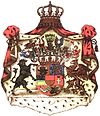
2nd generation Marie Sophie · Magdalene · Christiane · Caroline · Adolphus Frederick IV · Elisabeth · Sophie Luise · Charles II · Ernst Gottlob · Charlotte · Gotthilf · George Augustus3rd generation Charlotte Georgine · Caroline Auguste · Georg Carl · Therese · Friedrich Carl · Louise · Frederica · George · Carl · Auguste Albertine · Charles4th generation Luise · Frederick William · Caroline · George5th generation 6th generation 7th generation 8th generation 9th generation Olga · Alexander · MichaelCategories:- British royal consorts
- Hanoverian royal consorts
- Duchesses of Bremen and Verden
- Electresses of Hanover
- House of Hanover
- House of Mecklenburg-Strelitz
- People from Mecklenburg-Strelitz
- 1744 births
- 1818 deaths
- People from Mirow
- Duchesses of Mecklenburg-Strelitz
- Duchesses of Saxe-Lauenburg
- Royal Botanic Gardens, Kew
- George III of the United Kingdom
Wikimedia Foundation. 2010.

